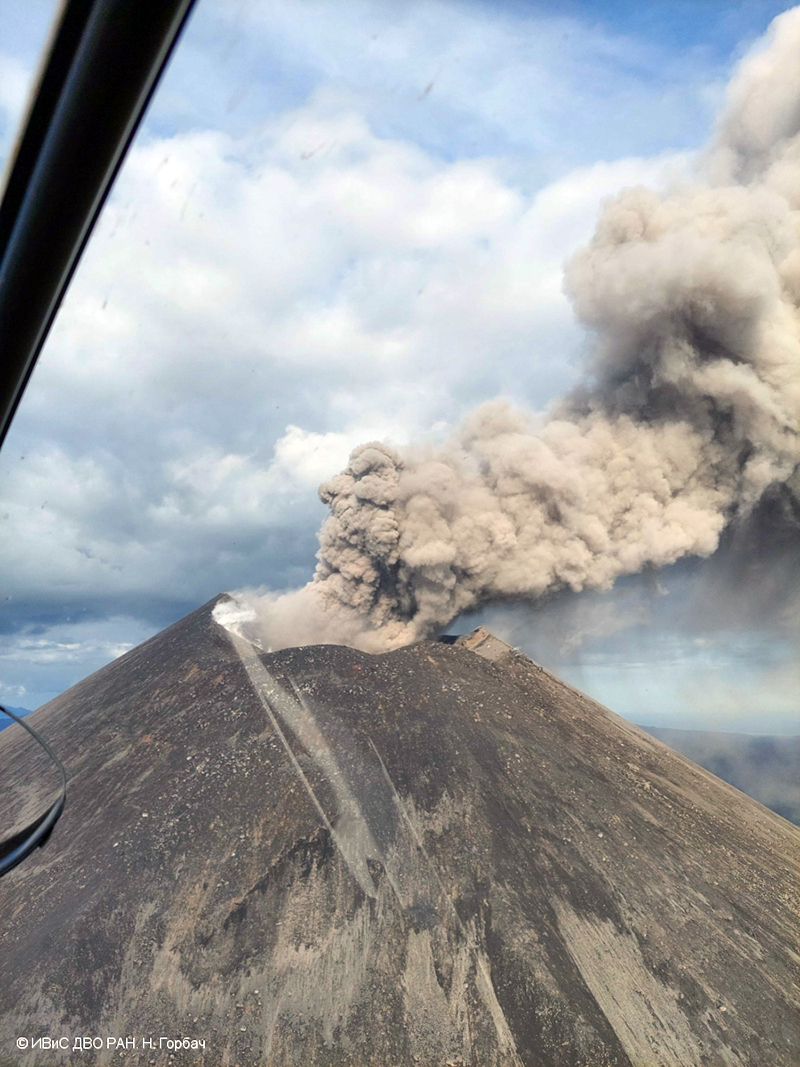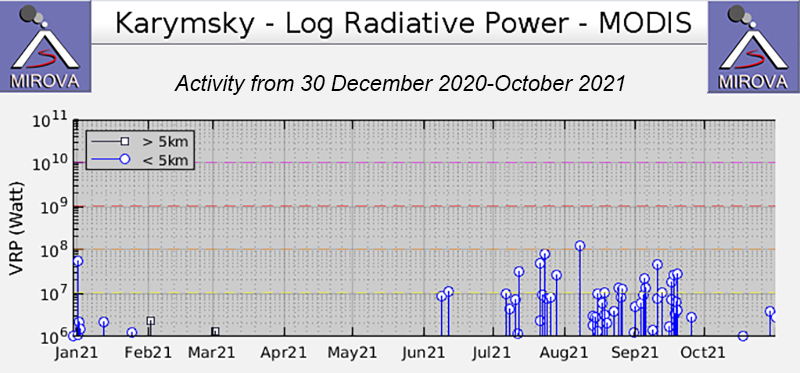Report on Karymsky (Russia) — November 2021
Bulletin of the Global Volcanism Network, vol. 46, no. 11 (November 2021)
Managing Editor: Edward Venzke.
Edited by Kadie L. Bennis.
Karymsky (Russia) Ash explosions during June-October 2021
Please cite this report as:
Global Volcanism Program, 2021. Report on Karymsky (Russia) (Bennis, K.L., and Venzke, E., eds.). Bulletin of the Global Volcanism Network, 46:11. Smithsonian Institution. https://doi.org/10.5479/si.GVP.BGVN202111-300130
Karymsky
Russia
54.049°N, 159.443°E; summit elev. 1513 m
All times are local (unless otherwise noted)
Karymsky is part of Kamchatka’s eastern volcanic zone is a highly active volcano that has been characterized by ash explosions, ash plumes, gas-and-steam plumes, and thermal anomalies. The most recent eruption began on April 2020 and has continued during this reporting period of May through October 2021; activity has included ash explosions, ash plumes, and resulting visible ash deposits (BGVN 46:05). Information comes from daily, weekly, and special reports from the Kamchatka Volcanic Eruptions Response Team (KVERT), the Tokyo Volcanic Ash Advisory Center (VAAC), and satellite data.
Activity during May and June was relatively low and consisted mostly of a weak thermal anomaly in the summit crater that was visible in satellite images during clear weather days. Thermal anomalies continued to be detected intermittently through the reporting period. During 6-8, 15, and 17 June ash plumes drifted 40-70 km NE.
Ash explosions and strong ash plumes were reported during July, along with a thermal anomaly. During 6-11 and 15 July ash plumes were noted in both KVERT VONAs (Volcano Observatory Notice for Aviation) and weekly reports; they rose to 1.1-2.5 km altitude and drifted 36-350 km in multiple directions (figure 58). Explosions during 21-23 July produced ash plumes that rose to 1.5-1.6 km altitude and drifted as far as 100 km SE, NE, and N (figure 59). Some of these stronger explosions were also detected in satellite data, accompanied by a strong thermal anomaly. Multiple explosions continued to be detected through the rest of July, which generated ash plumes that rose to 2 km altitude and drifted as far as 350 km E.
 |
Figure 58. Photo of an explosive eruption at Karymsky generating a strong ash plume on 9 July 2021. Photo by A. Reznikov; courtesy of IVS FEB RAS, KVERT. |
 |
Figure 59. Photo of the explosion at Karymsky that generated a dense gray ash plume on 24 July 2021. Photo by G. Volynets; courtesy of IVS FEB RAS, KVERT. |
Explosions continued into August, producing strong ash plumes, accompanied by a thermal anomaly. During 1, 4-5, 6-15, 19, and 27 August explosions produced gas-and-steam and ash plumes that rose to 1.3-2.5 km altitude and drifted 23-75 km SE and ESE (figure 60). The Tokyo VAAC reported that multiple ash plumes rose to 2.4-3.4 km altitude and drifted SE, SW, S, and E during 17-21 August. On 19 August an explosion generated an ash plume rose to 2-2.5 km altitude and drifted 60 km ESE. Ash plumes during 19-20 August rose to 2.4 km altitude and drifted E. During 20-27 August daily gas-and-ash plumes were detected in satellite images and extended 94 km NE, E, and SE. According to Tokyo VAAC advisories issued during 25-27 August ash plumes rose to 3-4.6 km altitude and drifted E and NE, based on information from Petropavlovsk-Kamchatsky Airport (UHPP) and satellite data. On 27 August gas-and-steam plumes containing some amount of ash extended for 94 km to the E, SE, and NE.
 |
Figure 60. Photo of an explosive event at Karymsky that generated an ash plume up to 3 km altitude on 8 August 2021. Photo by N. Gorbach; courtesy of IVS FEB RAS, KVERT. |
Intermittent explosions and ash plumes continued to be detected during September, rising as high as 1-7 km altitude, and drifting 25-180 km in multiple directions. An explosion on 10 September generated an ash plume to 2 km altitude that drifted 116 km E (figure 61). On 15 September an explosion produced an ash cloud that rose 2.5-3 km altitude was 11 km in diameter that drifted 180 km SE.
 |
Figure 61. Photo of an explosion and a strong ash plume at Karymsky on 10 September 2021. Photo by V. Malinovsky; courtesy of IVS FEB RAS, KVERT. |
On 19 October KVERT lowered the Aviation Color Code (ACC) to Yellow (the second lowest level on a four-color scale), reporting that only gas-and-steam emissions persisted after the ash explosions on 26 September. However, during 19-20 October explosions generated ash plumes that rose to 4-5 km altitude and drifted 90-225 km ENE, prompting KVERT to raise the ACC to Orange. Explosions continued during 22 and 26-30 October, producing ash plumes that rose to 2.3-4 km altitude and drifted 32-120 km E and SE.
MIROVA (Middle InfraRed Observation of Volcanic Activity) analysis of MODIS satellite data shows two moderate-power thermal anomalies in early June, followed by intermittent low- to moderate-power anomalies during July through September (figure 62). A total of five thermal alerts were detected by the MODVOLC thermal algorithm on 6, 21 (2), and 23 (2) July 2021. During clear weather days, much of this thermal activity was visible in Sentinel-2 infrared satellite imagery of the summit crater, accompanied by strong ash plumes and gas-and-steam emissions that drifted in different directions (figure 63).
Geological Summary. Karymsky, the most active volcano of Kamchatka's eastern volcanic zone, is a symmetrical stratovolcano constructed within a 5-km-wide caldera that formed during the early Holocene. The caldera cuts the south side of the Pleistocene Dvor volcano and is located outside the north margin of the large mid-Pleistocene Polovinka caldera, which contains the smaller Akademia Nauk and Odnoboky calderas. Most seismicity preceding Karymsky eruptions originated beneath Akademia Nauk caldera, located immediately south. The caldera enclosing Karymsky formed about 7600-7700 radiocarbon years ago; construction of the stratovolcano began about 2000 years later. The latest eruptive period began about 500 years ago, following a 2300-year quiescence. Much of the cone is mantled by lava flows less than 200 years old. Historical eruptions have been vulcanian or vulcanian-strombolian with moderate explosive activity and occasional lava flows from the summit crater.
Information Contacts: Kamchatka Volcanic Eruptions Response Team (KVERT), Far Eastern Branch, Russian Academy of Sciences, 9 Piip Blvd., Petropavlovsk-Kamchatsky, 683006, Russia (URL: http://www.kscnet.ru/ivs/kvert/); Tokyo Volcanic Ash Advisory Center (VAAC), 1-3-4 Otemachi, Chiyoda-ku, Tokyo 100-8122, Japan (URL: http://ds.data.jma.go.jp/svd/vaac/data/); MIROVA (Middle InfraRed Observation of Volcanic Activity), a collaborative project between the Universities of Turin and Florence (Italy) supported by the Centre for Volcanic Risk of the Italian Civil Protection Department (URL: http://www.mirovaweb.it/); Hawai'i Institute of Geophysics and Planetology (HIGP) - MODVOLC Thermal Alerts System, School of Ocean and Earth Science and Technology (SOEST), Univ. of Hawai'i, 2525 Correa Road, Honolulu, HI 96822, USA (URL: http://modis.higp.hawaii.edu/); Sentinel Hub Playground (URL: https://www.sentinel-hub.com/explore/sentinel-playground).



